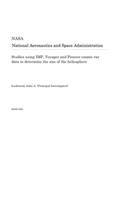
Studies Using Imp, Voyager and Pioneer Cosmic Ray Data to Determine the Size of the Heliosphere
Series:
The purpose of this project was to use the cosmic ray data from the IMP, Voyager and Pioneer spacecraft in the heliosphere out to approximately 65 AU to estimate the size of the heliosphere. We used several techniques to develop a consistent picture of the size of the heliosphere. The first method used a response function approach which determined the intensity as a function of time by scaling the
NaN
VOLUME
English
Paperback

The purpose of this project was to use the cosmic ray data from the IMP, Voyager and Pioneer spacecraft in the heliosphere out to approximately 65 AU to estimate the size of the heliosphere. We used several techniques to develop a consistent picture of the size of the heliosphere. The first method used a response function approach which determined the intensity as a function of time by scaling the modulation effect as they move outward and eventually reach the boundary of the heliosphere. In this model the effects of transient cosmic ray disturbances is included. A second approach using the perturbation method in which drifts are considered as a perturbation to the standard diffusion-convection modulation models was not fully developed. In a third approach the location of the modulation boundary beyond the termination shock was estimated using observations of the intensity and radial gradients between Voyager 2 and Pioneer 10 along with new estimates of the interstellar intensity of more than 70 MeV galactic cosmic rays. Using this method we found that for 7 years, from 1983 to 1990, the modulation boundary remained constant at 83 ]/- 5 AU. We infer from these studies that a modulation boundary can be estimated only by extrapolating the observed radial gradients when the solar magnetic field polarity is such that cosmic-ray particles are drifting in the heliosphere inward toward the Earth along the neutral sheet. The boundary distance is larger than the estimates of the location of the termination shock at 67 +/- 5 AU using the same method. Two other studies partially supported by this grant are attached. The first deals with the recovery period of the greater than 70 MeV cosmic rays in the outer heliosphere from 1992-1995. In the second paper we compare the rigidity dependence of the 11-year cosmic ray variation at the Earth in two cycles of opposite solar magnetic field polarity. Lockwood, John A. (Principal Investigator) Unspecified Center NAGW-3454...
Price Comparison [India]
In This Series
Bestseller Manga
Trending NEWS




















